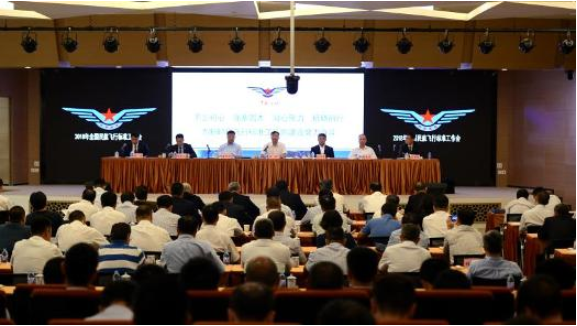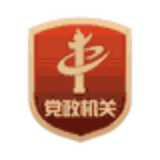
On August 23, the 2018 National Working Conference on Civil Aviation Flight Standards was held in Shanghai. The conference summarized the work related to civil aviation flight standards in the past seven years, analyzed the current situation in this regard, and studied and identified the general requirements and main tasks for the flight standardization community in the foreseeable future. Deputy Administrator of CAAC Li Jian attended the meeting and highlighted the importance of assuming responsibilities, taking practical actions, seizing the opportunities and taking advantage of the favorable conditions. In the course of building China into a strong civil aviation powerhouse, we should strive to improve the quality of flight standardization work, and make new achievements in order to write a new chapter for the civil aviation flight standardization work in a new era. Liu Shaoyong, Chairman of China Eastern Airlines Group, delivered a speech at the meeting.
Li Jian expressed that flight standardization work is the most important link in civil aviation safety, and the history of flight standardization management is an epitome of the safe Chinese civil aviation development. At present, China civil aviation has developed comprehensive rules and regulations and an FSOP supervision system that can cover all aspects of flight standardization. Through the certification and continuous supervision and inspection of the administrative counterparts, flight accidents have been fundamentally reduced. It has been proved by practice that flight standardization management serves as an important basis and means to safeguard the safety operation of civil aviation.
Li Jian pointed out that the safety management in the industry, represented by flight standards management, was fruitful and has made outstanding contributions to economic and social development. First, the institutional advantages have been given full play, leading to efficient execution and clear-cut accountability. Second, the management concept has been improved, and major changes in supervision were achieved; the awareness of keeping the bottom line of regulations was deeply rooted in the industry, and safeguarding the red line of integrity has become an important consensus of safety work; the implementation of safety management system (SMS) has brought about fundamental changes in management concepts. Third, a relatively complete regulatory system has been established after years of experience gathering. Chinese civil aviation flight standardization management covers 18 regulations, 387 normative documents and standards. Some of the management requirements are leading the world, including those related to high-plateau operation, the management of UAS, electronic license issuance and RNP AR technology application. Fourth, the regulatory model is unique and compatible with the operation of the industry. Fifth, systematic management style resulted in much more efficient supervision. Last but not least, by adhering to the concept of seeking innovation-driven development, a large number of technological innovations came into being, which greatly addressed the issue of safety and efficiency.
Li Jian pointed out that in terms of safety development, the industry still faces prominent problems, including the loose working style, insufficient management despite of rapidly expanding industry scale, the gap in the development of working style and theory, and the low contribution of Chinese standard to international civil aviation, which is not commensurate with the status of China as a large civil aviation country. To address these issues, we need to rise to the challenges, and attach great importance to truly solving the prominent problems in the industry, so as to remove the obstacles impeding the development. At present, as China's economy has entered a stage of high-quality development, the general requirement guiding the flight standardization work in the foreseeable further is: guided by Xi Jinping Thought on Socialism with Chinese Characteristics for a New Era and tasked with building an internationally first-class flight standardization management system, the flight standardization community shall strive for higher quality and efficiency as well as stronger driving forces to achieve an overall improvement in the quality of flight operations and in CAAC safety supervision efficiency, thus creating a favorable safe operation environment for the sustainable and healthy development of civil aviation and the building of a strong aviation powerhouse.
Li Jian urged the flight standardization community to innovate and assume responsibilities, in an effort to achieve transformation in four aspects: the Chinese flight standardization community shall transform its role on the international stage from being a follower to a leader by gaining a leadership role in international organizations and cooperation projects and having a greater say in the development of international standards; the community shall achieve a priority shift from quantity to quality by conducting high quality oversight while keeping the total amount of oversight activities stable; the community shall make a transition from government driven to market driven development, allowing a decisive role to be played by the market in resource allocation, by giving more power and freedom to the market and abolishing outdated way of thinking and institutional stereotypes; in terms of the working concept, the community shall transform from relying on foreign products to providing support to China-made products by being confident in domestically produced products and prioritizing the usage of domestic products so as to enable more Chinese products to be used in our civil aviation system.
Hu Zhenjiang, Director General of Flight Standard Department, CAAC, indicated in the working report on flight standardization that in the past seven years, especially since the 18th National Party Congress, the industry witnessed a marked increase in the number of enterprises, organizations, staff and aircraft, and a widespread application of new navigation technologies. As a result, civil aviation has made all-round achievement in flight standards management and experienced profound changes in this regard. First, to strengthen top level design, the industry made efforts to advocate law-based governance and improve system establishment by improving the system of regulations and standards, vigorously promoting system establishment, continuously strengthening staff training, adhering to the system of dual responsibilities on the same position and seeing governance over the Party is exercised fully and with rigor. Second, to adhere to the bottom line of ensuring safe operation, the industry implemented the requirement of zero tolerance for safety hazards by improving personnel qualifications, advancing work style development, focusing on addressing hidden hazards, establishing long-term safe operation mechanism, strengthening supervision of foreign airlines to ensure their safe operations in China, and improving aviation security for improved supporting capability. Third, the industry attached great importance to innovation and better management style. In this regard, efforts were made to innovate the mechanism of overseeing transport aviation; vigorously promote the development of general aviation industry, aim for the widespread application of new navigation technologies, explore the safety management mechanism of UAS, and continuously innovate aircraft evaluation. Fourth, in line with the overall national strategy, efforts were made to conduct test flights in the newly built airports in the South China Sea, give strong support to the safety operation and international operation of domestically produced civil aircraft, promote the establishment of a systematic aircraft tracking and monitoring system, and deepen the reform in terms of streamlining administration, delegating power, improving management and strengthening services to enhance people's sense of gains. Fifth, international exchanges as well as communication and cooperation were deepened. China civil aviation actively participated in the international civil aviation affairs, expanded bilateral and multilateral cooperation, and shared China wisdom and China approach with international civil aviation community, which continuously expanded the influence of China civil aviation in the world.
The report pointed out that with respect to the flight standardization work there were imbalances between: the training of professional workforce and the speed of industry development; the enhancement of management efficiency and the pace of industry development and reform; the resource supply and the need for safe operation in the industry; the basic research ability and the need for industry development; the building of supervision team and the need for safe industry development. With respect to the flight standardization work in the foreseeable future, efforts shall be made in further strengthening the development and improvement of laws and regulations, the operation safety of air transport and the management of personnel qualifications, in order to timely deal with general aviation, UASs, domestically produced civil aircraft, new navigation technologies, global energy conservation and emission reduction, the shortage of monitoring resources and other emerging situations, and promote the adoption by the international community of Chinese civil aviation standards. To further strengthen system building, efforts will be made to advance the Phase III construction of FSOP to achieve the goal of precise supervision based on connectivity and big data. Team building will be further reinforced to improve the capabilities of professionals in such areas as flight, maintenance and flight dispatch, and of inspector team. Party building will be granted priority as always by seeing governance over the Party is exercised fully and with rigor, so as to promote the safer development of civil aviation industry.
Present at the meeting were CAAC Chief Engineer, Inspector General of Aviation Safety, heads of various CAAC Departments, Regional Administrations as well as Safety Supervision Management Bureaus, persons in charge of safety supervision and flight standards development from air transport enterprises, general aviation enterprises, maintenance enterprises, aviation product manufacturers, industry associations, flight colleges and academic research institutes. By referring to the working report, the participants conducted group discussion based on their own working experience, and put forward many constructive comments and recommendations on the flight standardization work.

